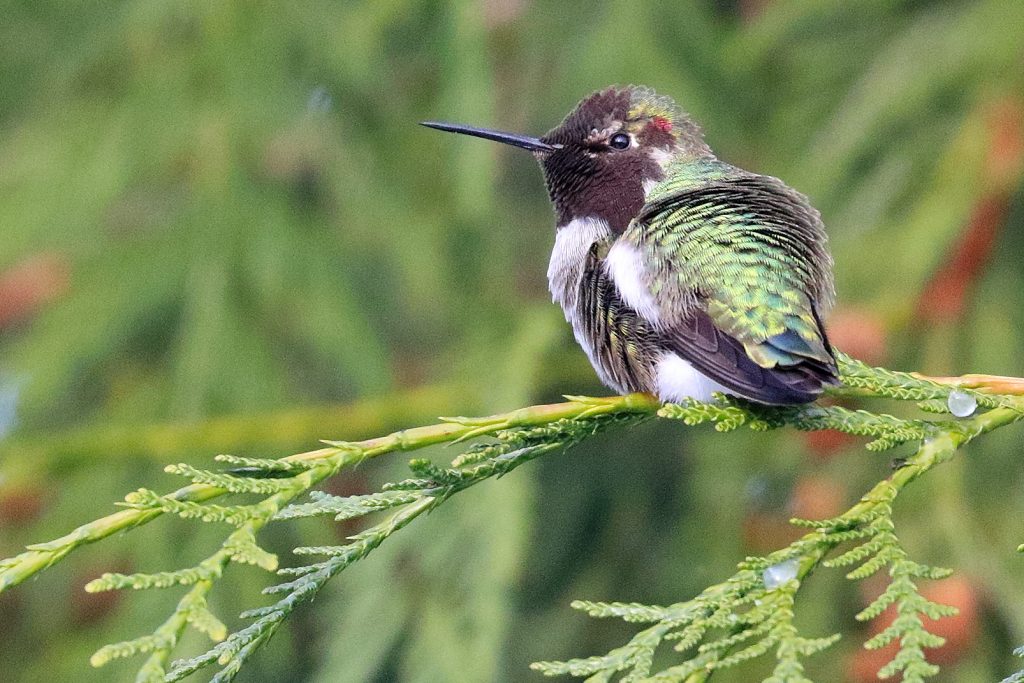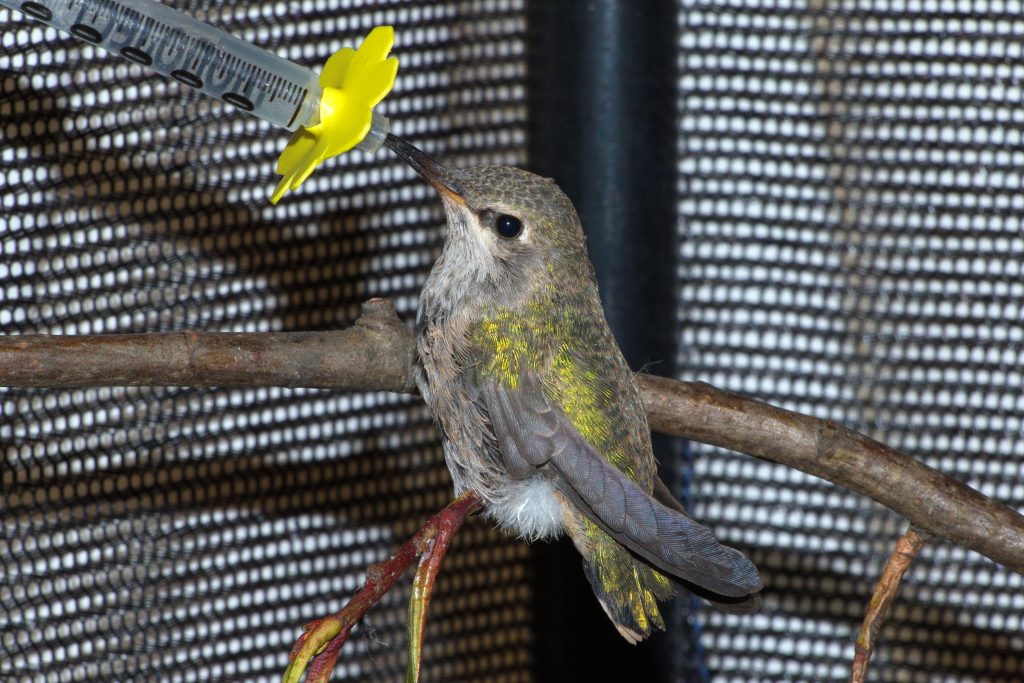Support Us
Since 1979 more than 140,000 animals have been treated by Wildlife Rescue.
Thanks to the support of individuals like you, Wildlife Rescue can provide a lifeline for animals in distress.
Hummingbirds – a crowd favourite, miniature acrobats that dart and dip, hunting for high-energy foods.
Although these tiny birds weigh less than a loonie (averaging between 3 and 6 grams), hummingbirds need to be almost constantly eating. Hummingbirds flap their wings 50 times or more per second in order to maintain their signature hovering flight. Undoubtedly, this requires an immense amount of energy. In order to fuel their flight, hummingbirds consume half their body weight in pure sugar every day!
Understandably, these tiny Aves are very vulnerable to changes in weather. Their food sources, insects and nectar-bearing flowering plants, become almost non-existent when winter comes. While most species of hummingbirds migrate south to find food, Anna’s Hummingbird stays on the Pacific coast year-round. You may also find other migratory hummingbird species that have delayed migration for a variety of reasons. Occasionally, younger birds get trapped in winter areas due to their inexperience, or they have gotten pushed off their migratory route by storms.
Hummingbirds don’t hibernate in the traditional sense, but they can go into an energy-conservation mode called “torpor” on cold winter nights. Torpor is a deep sleep state in which an animal decreases its metabolic rate in order to consume less energy. During this mini-hibernation, a hummingbird’s heart rate can decrease from 1,260 beats per minute to fewer than 50 beats per minute! They also decrease their body temperature from 40°C to 18°C. Yet even during torpor, a hummingbird’s metabolism is so high, they will lose around 10% of their body weight overnight. To deal with the scarcity of nectar, hummingbirds tend to eat more insects over the winter.
The strongest factor triggering migration is day length – hummingbirds will get restless and head south as days grow shorter in late summer. However, fewer hummingbirds are migrating as climate change is altering ecosystems, allowing for flowering plants to blossom year-round.
Please note, if you are putting up a hummingbird feeder this winter, you must maintain it properly and diligently. Improper care can be more harmful than helpful. An unmaintained feeder can lead to fungal infections, starvation, and death to the hummingbirds which have become dependent on them for survival.
Hummingbirds have the highest metabolism of any endothermic animal! A high metabolism calls for high energy fuel. It’s easy to see why hummingbirds love sugar!
Filling your feeder with a simple mixture of refined white table sugar dissolved in hot water is sufficient. Non-organic, cane, or beet sugars are the best.
The recommended sugar to water ratio is one cup of sugar to four cups of water. Most ornithologists agree that the nectar in your feeders should be as close as possible to that provided by nature. Flowers that coevolved with hummingbirds usually produce nectar that is relatively weak in sugar, containing 15-25% sucrose. This is why we recommend not more than 1 part sugar to 4 parts water.
You must ensure the sugar is pure white – a sign that the molasses has been removed. Molasses is high in iron and can be toxic to hummingbirds. NEVER use honey, brown sugar, icing sugar, juice, or artificial sweetener!
Please note there is no need to stain the sugar water with red food colouring! Hummingbirds are attracted by the red colours of the feeder itself, not the nectar inside, and food colouring could potentially be harmful.

Remember that hummingbird feeders require more attention than simply filling them with sugar water. They must be properly maintained in order to prevent harm.
Sugar ferments and when it does, it turns the sugar water into a rancid solution that can be fatal to hummingbirds. That is why it is so important to clean out your feeders every three to five days at a minimum, the more frequently the better. The feeder should be washed out with hot water and a bottle brush to prevent bacteria and mould growth, and make sure to scrub the flower feeders as well!
It is also important to choose a feeder that you can keep clean easily. This implies a simple design. Often the “arty” feeders are very beautiful to look at, but very difficult to keep clean.
It is important to keep your feeder and the nectar clean. Every time a bird dips its tongue into a feeder, it is inoculating the nectar with microbes. These microbes feast on the sugars and pretty soon, there is no sugar left, just an acidic, microbial cloud. Look at the feeder and ask yourself, ‘would I drink that?’. If the answer is no, it is time to get busy.
The best practice is to clean the feeder every time you refresh the nectar. This should occur every few days in summer and at least once a week in winter.
If you live in an area where temperatures dip below freezing, you will have to make sure your feeders don’t freeze. Here are a few tips and tricks to prevent your hummingbird nectar from freezing this winter:
1. Place your feeder in a protected place – a covered porch or a windbreak will prevent the feeder from getting covered with snow or ice and keep it unfrozen longer.
2. Use window feeders. The heat from the inside of your home will transfer to the feeder and keep the nectar from freezing. Of course, this works best on single-paned windows and will only work to certain temperatures, but it will also give you a superb view so no harm trying!
3. Have two feeders. Simply switch them out as they freeze. This technique will also help you keep your feeders nice and clean as you can wash them out as you swap them!
4. Decorate your feeder for the holidays! Yes, really. Wrapping a strand of holiday lights (non-LED) around the feeder can generate enough warmth to prevent them from freezing! This technique is best used on glass feeders – we don’t want to melt any plastic feeders!
Every winter our Wildlife Hospital sees an influx of hummingbirds freezing and starving, in critical condition. Some show signs of bacterial and fungal infection caused by dirty feeders. To compound the severity of this situation, these infections are often contagious and can spread quickly from feeder to feeder.
Some signs to watch for are birds on the ground, weak, confused, soiled, tongue sticking out, visible injuries, or unable to fly.
If you find a hummingbird or other animals in distress, please contact our Support Centre.